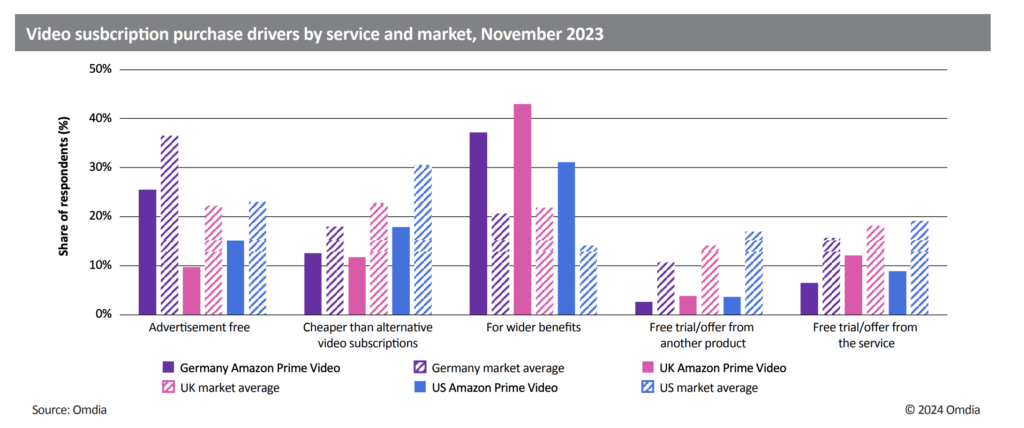DTVE Data Weekly: Amazon enters the hybrid video era with Prime Video ads

Source: Omdia
On January 29 in the US and February 5 in Canada, Germany, and the UK, Amazon Prime Video users began to experience advertisements within the service. An advertising-free video experience with Prime Video now costs 2.99 (USD, CAD, EUR, or GBP, respectively) as a monthly add-on to the service. The sports and live TV included within Amazon Prime Video and any ad-supported subscriptions through Amazon Channels will continue to show advertising as before, even with the Ad Free add-on.
Amazon offers a variety of tiers for accessing the Prime bundle and Prime Video content, and, depending on tier, the add-on increases the monthly equivalent price by 20–80%. The relative price increase for international markets is particularly high compared to the US Prime service, with rates that match or exceed that of the Prime subscription price increases seen in 2022.
For those unwilling to pay more or experience advertising within Prime Video, Amazon has offered pro-rata refunds to annual Prime members. Furthermore, the Ad Free membership is a monthly option with no annual plan currently available. This means that the add-on can be added or removed as necessary without a sustained pricing burden on the consumer, allowing Amazon to capitalize on the seasonality of its content releases amid a background of ad-supported viewing.
The immediate shift of international Prime Video users onto a hybrid model sets Amazon apart from fellow video services, with services such as Netflix and Disney+ offering an opt-in approach to reach new audiences. Omdia Consumer Research suggests that advertisement-free content varies in importance substantially between markets and video services, with it being less important in the US and UK than in markets such as Germany. In all these cases, however, Amazon Prime Video falls below market averages for the importance of advertisement-free content. Such variance between markets will likely result in different levels of consumer inertia to subscribe to the Ad Free add-on—and different levels of disdain for its introduction.
Omdia forecasts that the incremental revenue generated by the Ad Free Prime Video add-on and the advertising-supported video will increase revenue attributable to video by more than 50% across the US, Canada, Germany, and the UK in 2024.
Despite the prevalence of Prime Video as an aspect of the wider Amazon Prime service, there are still ~100 million Prime subscribers who do not make monthly use of Prime Video.
The fundamentally different way Amazon markets its video services means that this change is unlikely to fuel new additions to the Prime service. Amazon will instead capitalize on its current user base to drive incremental, video-dedicated revenue. Omdia forecasts that the incremental revenue generated by the Ad Free Prime Video add-on and the advertisingsupported video will increase revenue attributable to video by more than 50% across the US, Canada, Germany, and the UK in 2024. This is set to make Amazon the second-largest online video platform by hybrid advertising-supported video revenue globally in 2024, behind Disney but ahead of NBCU’s Peacock, Paramount+, and Netflix.
Max Signorelli is Omdia’s principal analyst for media & entertainment. Read the full report here.
